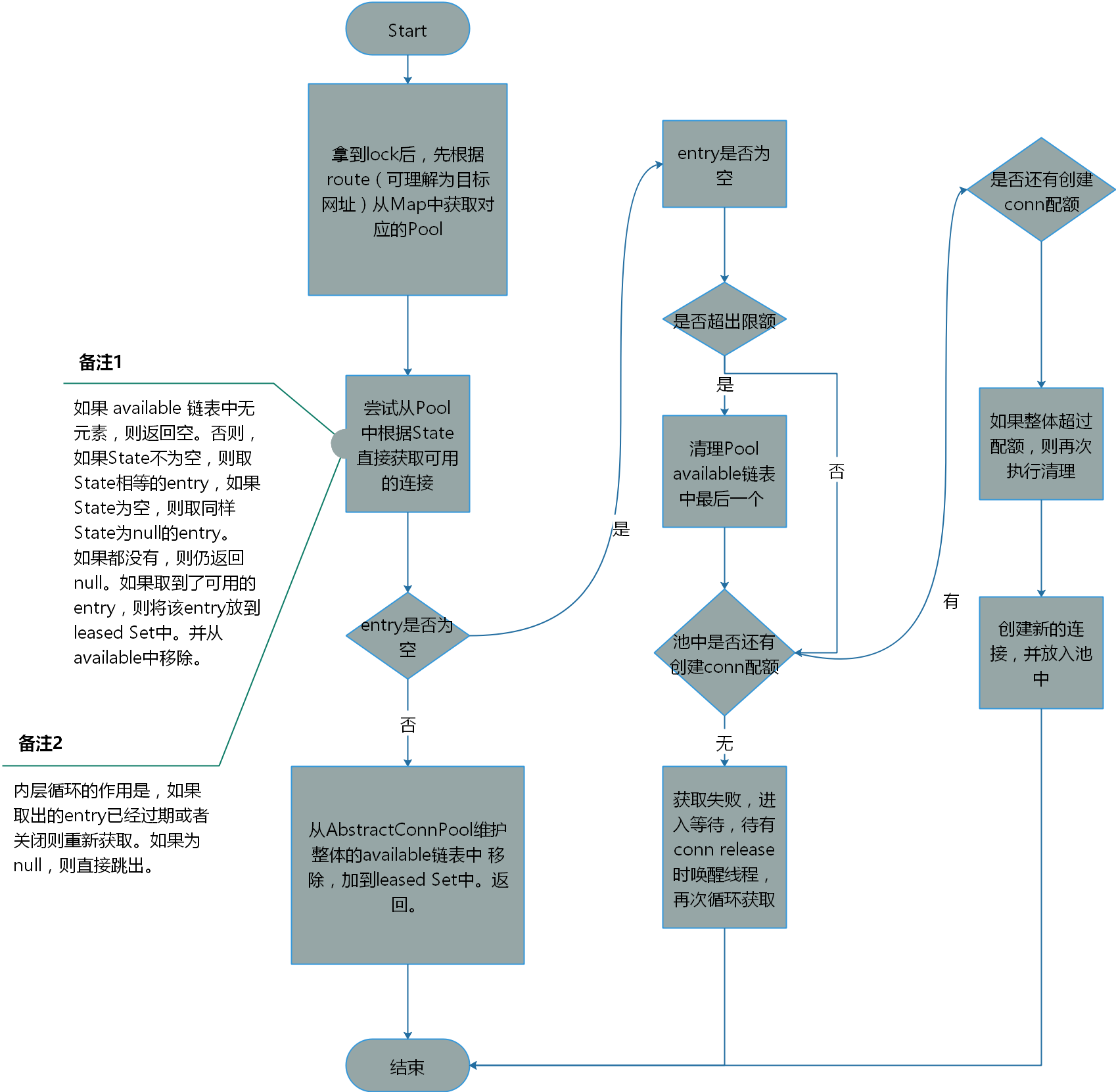Httpcomponents-core 从池中获取连接代码解析
最近使用Httpcomponents-client过程中遇到一个线程阻塞的问题。通过jstack dump线程发现,是block在AbstractConnPool的getPoolEntryBlocking中,于是决定研究一下Httpcomponents-client的源码。
问题背景
邮件发送线程阻塞,jstack dump发现如下问题:
可见,阻塞发生在Httpcomponents-client内部。于是准备调研一下。
Httpcomponents-client连接池
Apache Httpcomponents-client是一个常用的Http客户端工具包,其底层通过socket绑定到指定目标,通过socket的io流发送和接受http协议相关信息。
出于效率考虑,httpclient底层利用一个连接池将socket连接缓存起来便于复用。本次研究的代码,就是关于httpcomponents-core 从池中获取连接的逻辑判断部分。代码如下(MyLogFactory部分是本人为研究自行添加的日志):
1
2
3
4
5
6
7
8
9
10
11
12
13
14
15
16
17
18
19
20
21
22
23
24
25
26
27
28
29
30
31
32
33
34
35
36
37
38
39
40
41
42
43
44
45
46
47
48
49
50
51
52
53
54
55
56
57
58
59
60
61
62
63
64
65
66
67
68
69
70
71
72
73
74
75
76
77
78
79
80
81
82
83
84
85
86
87
88
89
90
91
92
93
94
95
96
97
98
99
100
101
102
103
104
105
106
107
108
109
110
111
private E getPoolEntryBlocking(
final T route, final Object state,
final long timeout, final TimeUnit tunit,
final Future<E> future) throws IOException, InterruptedException, TimeoutException {
Date deadline = null;
if (timeout > 0) {
deadline = new Date(System.currentTimeMillis() + tunit.toMillis(timeout));
}
this.lock.lock();
try {
final RouteSpecificPool<T, C, E> pool = getPool(route);
E entry;
for (; ; ) {
Asserts.check(!this.isShutDown, "Connection pool shut down");
for (; ; ) {
entry = pool.getFree(state);
if (entry == null) {
break;
}
if (entry.isExpired(System.currentTimeMillis())) {
entry.close();
}
if (entry.isClosed()) {
this.available.remove(entry);
pool.free(entry, false);
} else {
break;
}
}
if (entry != null) {
this.available.remove(entry);
this.leased.add(entry);
onReuse(entry);
return entry;
}
// New connection is needed
final int maxPerRoute = getMax(route);
MyLogFactory.getPoolEntryBlockingLog().debug("Max conn count per route, default is 2. [" + maxPerRoute + "].");
// Shrink the pool prior to allocating a new connection
final int excess = Math.max(0, pool.getAllocatedCount() + 1 - maxPerRoute);
MyLogFactory.getPoolEntryBlockingLog().debug("excess conn count [" + excess + "]. " +
"getAllocatedCount means: available + leased.");
if (excess > 0) {
for (int i = 0; i < excess; i++) {
final E lastUsed = pool.getLastUsed();
if (lastUsed == null) {
break;
}
lastUsed.close();
this.available.remove(lastUsed);
pool.remove(lastUsed);
}
}
if (pool.getAllocatedCount() < maxPerRoute) {
final int totalUsed = this.leased.size();
final int freeCapacity = Math.max(this.maxTotal - totalUsed, 0);
MyLogFactory.getPoolEntryBlockingLog().debug("Free capacity is: [" + freeCapacity + "]. MaxTotal(default 20) - leased.size");
if (freeCapacity > 0) {
final int totalAvailable = this.available.size();
if (totalAvailable > freeCapacity - 1) {
if (!this.available.isEmpty()) {
final E lastUsed = this.available.removeLast();
lastUsed.close();
final RouteSpecificPool<T, C, E> otherpool = getPool(lastUsed.getRoute());
otherpool.remove(lastUsed);
}
}
final C conn = this.connFactory.create(route);
entry = pool.add(conn);
this.leased.add(entry);
return entry;
}
}
boolean success = false;
try {
if (future.isCancelled()) {
throw new InterruptedException("Operation interrupted");
}
pool.queue(future);
this.pending.add(future);
if (deadline != null) {
success = this.condition.awaitUntil(deadline);
} else {
this.condition.await();
success = true;
}
if (future.isCancelled()) {
throw new InterruptedException("Operation interrupted");
}
} finally {
// In case of 'success', we were woken up by the
// connection pool and should now have a connection
// waiting for us, or else we're shutting down.
// Just continue in the loop, both cases are checked.
pool.unqueue(future);
this.pending.remove(future);
}
// check for spurious wakeup vs. timeout
if (!success && (deadline != null && deadline.getTime() <= System.currentTimeMillis())) {
break;
}
}
throw new TimeoutException("Timeout waiting for connection");
} finally {
this.lock.unlock();
}
}
流程分析
问题分析
通过源码阅读,我们已经大概了解的问题发生的过程。由于我们有3个线程同时发送邮件(不好的设计),而该3个线程需要访问同一个route去获取相关信息,而每个route默认的pool count是2。因此,当出现问题连接没有释放的时候,就会出现等待情况。而我们又没有设计等待超时,就会一直等待。
下一步,我准备调研一下,连接释放的逻辑,确定下未释放的原因。
关于源码学习
我fork了一份httpcomponents的源码,增加了一些学习标记用的log。如需要可自行fork。
httpcomponents-core
https://github.com/lihongzheshuai/httpcomponents-core
httpcomponents-client
https://github.com/lihongzheshuai/httpcomponents-client

